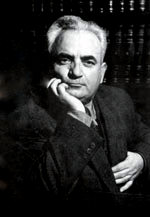One of the best specialists of Western Armenian culture in Soviet Armenia, Garnik (Der) Stepanian was born on February 14, 1909, in the village of Mamakhatoun, district of Derjan, in the area of Erzinga. In May 1915 most Armenians of Derjan were killed during the genocide; many were forcibly converted to Islam, and the remainders were deported towards Der-Zor. Young Garnik managed to survive and, after the war, he reached Sepastia, where he received elementary education. In 1923 he was moved to Greece together with many Armenian orphans, where he found shelter in the orphanages of Edipsos, Khalkis, and Oropos. Two years later, he found his way to Egypt and worked for the next five years as a typesetter in the daily Arev and the printing house Voskedar.
Stepanian’s life would make a turn in 1930 when he immigrated to Soviet Armenia and found his lost parents there. He continued working as a typesetter, this time at the first printing shop of the State Publishing House. In 1938 he graduated from the Faculty of Philology of Yerevan State University. Meanwhile, he taught Armenian language and literature at the Alexander Tamanian technical school (1937-1939), and Classical Armenian at the Faculty of Philology from 1939-1940. He was a student of famous linguist Hrachia Adjarian, about whom he would write an intriguing memoir (1976).
He wore several hats in the editorial world: he worked at the daily Sovetakan Hayastan, the monthly Sovetakan Hayastan (published for the Armenians of the Diaspora), and the monthly Teghekagir, the social studies publication of the Academy of Sciences of Armenia. In 1943 he became a member of the Writers Union of Armenia and two years later, he published the first novel about the Armenian Genocide in Soviet Armenia, Nightmarish Days (1945), based on his own experience, which was reprinted three times.
Garnik Stepanian worked at the Institute of Literature of the Academy, directed the Museum of Literature and Art from 1954-1963, and was a researcher at the Institute of Art of the Academy from 1963 until his death. He became a prolific and well-regarded name as a historian of Armenian culture, specializing in the fields of Western Armenian literature and theater. He authored monographs about several famous actors in the history of Western Armenian theater, like Bedros Atamian, Arusiag Papazian, Megerdich Djanan, and Siranush, a volume of correspondence by Atamian, and a memoir about another famous actor, Vahram Papazian. His most important contribution to the field was the seminal three-volume monograph, Outline of the History of Western Armenian Theater (1962, 1969, 1975). He would also delve into the theater of the Diaspora, with a series entitled Essays on the History of Diasporan Armenian Theater, of which he managed to write two volumes on French-Armenian (1982) and Armenian-American theater (posthumously published, 2008).
Stepanian not only published monographs on two famous Western Armenian writers, Arpiar Arpiarian (1955) and Hagop Baronian (1956, 1964), but he also translated from Turkish into Armenian the first Turkish novel, Hovsep Vartanian’s Akaby (1953, originally published in 1851), and several works by Baronian.
Another important contribution by Stepanian to the field of Armenian Studies was his three-volume Biographical Dictionary (1973, 1981, 1990), which unfortunately remained unfinished .
In 1967 he earned the title of Emeritus Art Worker of Armenia and four years later he defended his second doctoral thesis in the field of art. In 1980 he was a co-winner of the State Prize of Armenia for the five-volume collective work, History of Modern Armenian Literature.
Stepanian passed away on July 1, 1989, in Yerevan. Among his posthumous works is an especially remarkable 600-page monograph on the history of his birthplace, Erzinga (2005).
